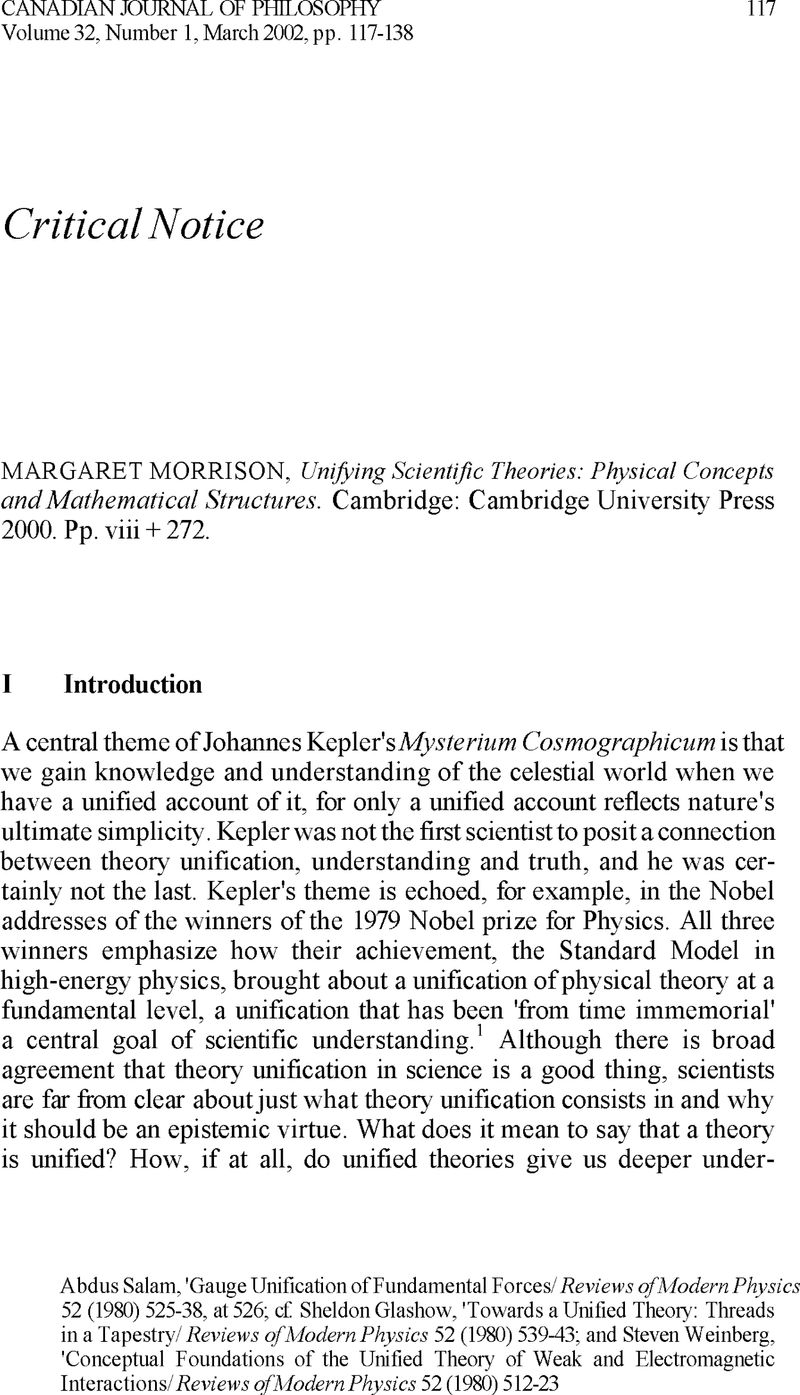Published online by Cambridge University Press: 01 January 2020

Abdus Salam, ‘Gauge Unification of Fundamental Forces/ Reviews of Modern Physics 52 (1980) 525-38, at 526; c f . Sheldon Glashow, ‘Towards a Unified Theory: Threads in a Tapestry/ Reviews of Modern Physics 52 (1980) 539-43; and Steven Weinberg, ‘Conceptual Foundations of the Unified Theory of Weak and Electromagnetic Interactions/ Reviews of Modern Physics 52 (1980) 512-23
2 Clark Glymour, ‘Explanations, Tests, Unity and Necessity/ Nous 14 (1980) 31-50; Michael Friedman, Foundations of Space-Time Theories (Princeton: Princeton University Press 1983) ; John Watkins, Science and Scepticism (Princeton: Princeton University Press 1984); Philip Kitcher, ‘Explanatory Unification/ Philosophy of Science 48 (1981) 507-31 and ‘Explanatory Unification and the Causal Structure of the World/ in Minnesota Studies in the Philosophy of Science Volume XIII, P. Kitcher and W.C. Salmon, eds. (Minneapolis: University of Minnesota Press 1989)
3 The Disorder of Things: Metaphysical Foundations of the Disunity of Science (Cambridge, MA: Harvard University Press 1993)
4 Peter Louis Galison and David J. Stump, eds., The Disunity of Science: Boundaries, Contexts, and Power (Stanford, CA: Stanford University Press 1 9 9 6 )
5 This review focuses on the philosophical aspects of Unifying Scientific Theories, and space does not permit a discussion of many of the case studies and historical claims contained in the book.
6 Page references are to Morrison, Unifying Scientific Theories unless otherwise indicated.
7 Cf. Paul Oppenheim and Hilary Putnam, ‘Unity of Science as a Working Hypothesis/ in Minnesota Studies in the Philosophy of Science, Volume II, H. Feigl, M. Scriven, and G. Maxwell, eds. (Minneapolis: University of Minnesota Press 1958).
8 William Whewell, Theory of Scientific Method, R. Butts, ed. (Indianapolis, IN: Hackett 1968)
9 Wesley Salmon, Scientific Explanation and the Causal Structure of the World (Princeton: Princeton University Press 1984)
10 Carl G. Hempel, Aspects of Scientific Explanation (New York: Free Press 1965); Philip Kitcher, ‘Explanatory Unification & Causal Structure'
11 Wesley Salmon, Scientific Explanation; ‘Conflicting Conceptions of Scientific Explanation/ Journal of Philosophy 82 (1985) 651-4; ‘Four Decades of Scientific Explanation/ in Minnesota Studies in the Philosophy of Science, Volume XIII, P. Kitcher and W.C. Salmon, eds.
12 Michael Friedman, ‘Explanation and Scientific Understanding/ Journal of Philosophy 71 (1974) 5-19; cf . Andre Kukla, ‘Scientific Realism and Theoretical Unification/ Analysis 55 (199) 230-8
13 C f . Margaret Morrison, ‘Models as Autonomous Agents/ in Models as Mediators: Perspectives on Natural and Social Science, M.S. Morgan and M. Morrison, eds. (Cambridge: Cambridge University Press 1999).
14 William Harper, ‘Consilience and Natural Kind Reasoning/ in An Intimate Relation: Studies in the History and Philosophy of Science, J.R. Brown and J. Mittelstrass, eds. (Dordrecht: Kluwer 1989) 125-31)
15 Malcolm Forster, ‘Unification, Explanation and the Composition of Causes in Newtonian Mechanics/ Studies in History and Philosophy of Science 19 (1988) 55-101
16 Malcolm Forster and Elliott Sober, ‘How to Tell When Simpler, More Unified, or L e s s “Ad Hoc” Theories Will Provide More Accurate Predictions/ British Journal for the Philosophy of Science 45 (1994) 1-35
17 Of course, nothing said so far justifies such an ontological commitment. There are well-known worries that this kind of ontological commitment might be incompatible with quantum theories in general (Arthur Fine, The Shaky Game: Einstein, Realism and the Quantum Theory [Chicago: University of Chicago Press 1986]) as well as more specific arguments that quantum fields themselves might not have a coherent physical interpretation (Paul Teller, An Interpretive Introduction to Quantum Field Theory [Princeton: Princeton University Press 1995]).
18 Salam, ‘Gauge Unification'; Weinberg, ‘Conceptual Foundations'; Glashow, ‘Towards a Unified Theory’; c f . Lillian Hoddeson, Michael Riordan, Max Dresden, and Laurie Brown, The Rise of the Standard Model: Particle Physics in the 1960s and 1970s (Cambridge: Cambridge University Press 1997)
19 Thomas S. Kuhn, The Structure of Scientific Revolutions (Chicago: University of Chicago Press 1970)
20 Philip Kitcher, ‘Explanation, Conjunction, and Unification/ Journal of Philosophy 73 (1976) 207-12
21 Andrew Wayne, ‘Theoretical Unity: The Case of the Standard Model/ Perspectives on Science 4 (1996) 391-407
22 I would like to thank Bill Harper, Margaret Morrison, and Alexander Rueger and for helpful discussions, and Louis Charland, Don Dedrick, Rodney Snooks, and Bill Vanderburg for helpful comments on an earlier draft of this paper. This paper is dedicated to the memory of Wesley Salmon.